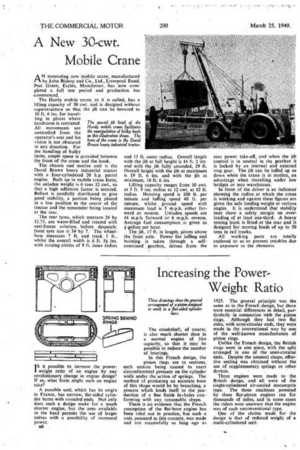A New 30-cwt.
Page 16

If you've noticed an error in this article please click here to report it so we can fix it.
Mobile Crane
A'interesting new mobile crane, manufactured by John Bishop and Co., Ltd., Liverpool Road, Peel Green, Eccles, Manchester, has now completed a full test period and production has commenced.
The Hardy mobile crane, as it is called, has a lifting capacity of 30 cwt. and is designed without superstructure so that the jib can be lowered to 10 ft. 6 ins, for travelling in places where headroom is restricted. All movements are controlled from the operator's seat and his vision is not obscured in any direction. For the handling of bulky items, ample space is provided between the front of the crane and the hook.
The chassis and motive unit is the David Brown heavy industrial tractor with a four-cylindered 20 h.p. petrol engine. Built up in mobile crane form, the unladen weight is 6 tons 12 cwt., so that a high adhesion factor is secured. Ballast is carefully distributed to give good stability, a portion being placed in a low position in the centre of the tractor and the remainder being located at the rear.
The rear tyres, which measure 24 by 12.75, are water-filled and treated with anti-freeze solution, before despatch; front tyre size is 141by 7. The Nvtieelbase measures 7 ft. and track 5 ft., whilst the overall width is 6 ft. 5-i ins. with turning circles of 9 ft. inner radius
The special jib head of the Hardy mobile crane facilitates the manipulation of bulky loads as this illustration shows. The basis of the crane is the David Brown heavy industrial tractor.
and 15 ft. outer radius. Overall length with the jib at full height is 14 ft. 2 ins. and with the jib fully extended, 29 ft. Overall height with the jib at maximum is 19 ft. 6 ins, and with the jib at minimum, 10 ft. 6 ins.
Lifting capacity ranges from 30 cwt. at 5 ft. 9 ins, radius to 12 cwt. at 12 ft. radius. Hoisting speed is 100 ft. per minute and lulling, speed 40 ft. per minute, whilst ground speed with maximum load is 5 m.p.h. either forward or reverse. Unladen. speeds are 14 m.p.h forward or 6 m.p.h. reverse. Average fuel consumption is given as fgallon per hour.
The jib, 17 ft. in length, pivots above the front axle. Power for luffing and hoisting is taken through a selfcontained gearbox, driven from the rear power take-off, and when the jib control is in neutral in the gearbox it is locked by an internal and external ring gear. The jib can be lulled up or down while the crane is in motion, an advantage when travelling under low bridges or into warehouses. •
In front of the driver is an indicator showing the radius at which the crane is working and against these figures are given the safe loading weight at various angles. It is understood that stability tests show a safety margin on Overloading of at least one-third. A heavy towing hook is fittedrat the rear dud is designed for moving toads of up to 50 tons in rail trucks.
All working parts are totally enclosed so as to prevent troubles due to exposure to the elements.


























